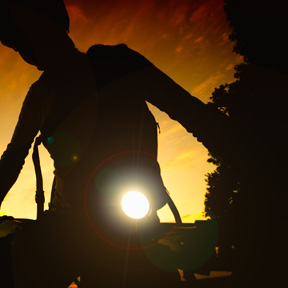Bicyclists – Be road wise
Under Texas law, a bicycle is a vehicle. So, a person operating a bicycle has the rights and duties applicable to a driver operating a vehicle. All laws and signs that regulate the movement of vehicles on the roadway also apply to bicycles. Therefore, a bicyclist should be road wise and obey all traffic laws, signs, and signals. This includes stopping at all stop signs and all top (red) lights.
Bicyclists must use hand signals to signal their intent to stop, turn left or turn right. These signals are expressed in the following way:
- Stop: extend the left hand and arm downward.
- Left turn: extend the left hand and arm horizontally.
- Right turn: extend the left hand and arm upward, or extend the right hand and arm horizontally.
A bicyclist traveling on a roadway moving slower than other traffic must ride as near as possible to the right curb or edge of the roadway. There are a few exceptions. Bicyclists can take the full lane of travel when:
- passing another vehicle moving in the same direction,
- preparing to turn left at an intersection or onto a private road or driveway,
- there are unsafe conditions on the roadway that prevents the cyclists from safely riding next to the curb or edge of the roadway, or
- a lane is less than 14 feet in width with no designated bicycle lane adjacent to that lane, making it unsafe for a bicycle and a motor vehicle to travel safely side by side.

Where Can I Ride? Operate bicycles on streets, roadways, bike paths, routes, and areas specifically designated for bicycle riding.
Can I Ride Side by Side? You can ride side by side with another cyclist as long as it does not impede traffic and you keep to a single lane. Do not ride more than two abreast unless you are on a bike-only road or trail.
Do I really need lights?
Yes. The law requires that, when riding at night, your bicycle must have:
- A front headlamp that can be seen from at least 500 feet away, and
- A red reflector (visible from 300 feet away) or red lamp (visible from 500 feet) on the back of the bicycle.
The truth about bike lanes.
- While cars must stay out of bike lanes, bicyclists do not have to stay in the bike lane.
A bicycle is a vehicle.
- Bicycles can and should ride on streets and roadways, not on sidewalks.
- At intersections, follow the same right of way rules that you would with other road users.
Motorists – Be bike wise
- Don’t crowd a cyclist when passing. A good rule of thumb: leave at least 3 feet between your car and the cyclists.
- Don’t “tailgate” a bicycle.
Look for bikes on the right (mostly).
Cyclists mostly ride close to the side of the road payement, but can take the full lane when:
- Passing another bicycle,
- Preparing to turn left,
- The right side lane is blocked, and
- The travel lane is too narrow for a bicycle and a car to travel side by side.




Join the Ride!